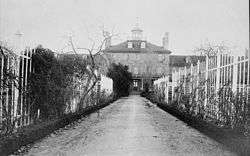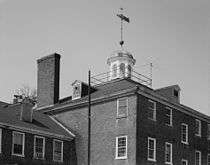Philadelphia Lazaretto
The Philadelphia Lazaretto was the first quarantine hospital in the United States, built in 1799, in Tinicum Township, Delaware County, Pennsylvania.[3] The site was originally inhabited by the Lenni Lenape, and then the first Swedish settlers in America. Nearby Province Island was the site of the confinement of the Christian Moravian Indians who were brought there under protective custody from Lancaster, PA in 1763 when their lives were threatened by the Paxton Boys. The facility predates similar national landmarks such as Ellis Island Immigrant Hospital and Angel Island and is considered both the oldest surviving quarantine hospital and the last surviving example of its type in the United States.[4]
The Lazaretto | |
U.S. National Register of Historic Places | |
Pennsylvania state historical marker | |
 Lazaretto in 1936 | |
  | |
| Location | Wanamaker Ave. and 2nd St., Essington, Pennsylvania |
|---|---|
| Coordinates | 39°51′38″N 75°18′2″W |
| Area | 10 acres (40,000 m2) |
| Built | 1799 |
| Architectural style | Georgian, Federal |
| NRHP reference # | 72001119[1] |
| Significant dates | |
| Added to NRHP | March 16, 1972 |
| Designated PHMC | October 25, 2008[2] |
History
The first quarantine station for the city of Philadelphia was erected in 1743 just southwest of where the Schuylkill and Delaware Rivers meet on the modern Penrose Ferry Road. A building was erected for use by sick people arriving at the port of Philadelphia and was known as the Pest House or the Old Lazaretto. The building was sold in 1802, with the proceeds used to help pay for the newly built Lazaretto, located about six miles west.[5][6]
Efforts to control disease epidemics in the City of Philadelphia did not begin in earnest until after the devastating Yellow Fever Epidemic of 1793, which killed between 4,000 and 5,000 inhabitants—about one-tenth of the city's population at the time—and led the national government, which was then located there, to temporarily move out of the city. Following that epidemic, the commonwealth of Pennsylvania in 1798 created a Board of Health, controlled by the city, with the power to levy taxes for public health measures.[5] The following year, the city Board of Health erected the Lazaretto on a 10-acre (40,000 m2) site ten miles (16 km) south of the city on the banks of the Delaware in Tinicum Township.[3][4]
In 1864, the municipal hospital of Philadelphia burned down and the board of health relocated it to the Lazaretto. Dr. J.L Forwood managed the hospital at the Lazaretto until the new building were completed.[7]
The new quarantine station included a hospital, offices, and residences.[4] All passenger and cargo vessels bound for the port of Philadelphia were required to dock at the Lazaretto for inspection.[3] Passengers suspected of contagion were quarantined in the hospital, and all suspect cargo was stored in the public warehouse.[3] The Board of Health of the City of Philadelphia operated the facility and enforced the local quarantine regulations until the Commonwealth of Pennsylvania assumed authority for enforcing quarantine regulations in 1893.[3] After it was closed as a hospital, it was used as an aviation base.[8]
The building was listed in the National Register of Historic Places in 1972.[9] In the early 21st century, the site was threatened with development, but the work of local preservationists saved it from leveling.[10]
- The Lazaretto in 2009
See also
 | |
- Bedloe's Island
- Fort Mifflin
- Lazaretto
References
- "National Register Information System". National Register of Historic Places. National Park Service. January 23, 2007.
- "PHMC Historical Markers". Historical Marker Database. Pennsylvania Historical & Museum Commission. Retrieved December 20, 2013.
- "Contagious Disease Control, The Lazaretto". City of Philadelphia. Archived from the original on May 8, 2008. Retrieved November 21, 2007.
- "Lazaretto Quarantine Station, Tinicum Township, Delaware County, PA: History". ushistory.org. Retrieved April 24, 2008.
- "Lazaretto: Time Line". ushistory.org. Retrieved April 26, 2008.
- Journal of the Common Council, of the City of Philadelphia, Appendix. Philadelphia: J. Van Court, Printer. 1861. pp. 691–692.
- Ashmead, Henry Graham (1884). History of Delaware County, Pennsylvania. Philadelphia: L.H. Everts & Co. p. 263. Retrieved July 19, 2018.
- Mason, Todd (June 21, 2006). "A preservation battle over immigrant site". Philadelphia Inquirer.
- "The Lazaretto". Preservation Alliance for Greater Philadelphia. March 7, 2008. Archived from the original on August 14, 2007. Retrieved March 7, 2008.
- DiGiacomo, Marlene (November 9, 2006). "Lazaretto property has been preserved". Delaware County Daily Times. Retrieved November 21, 2007.
- "The Historic Lazaretto, "Ellis Island's Great-Grandfather"". University of Pennsylvania. Retrieved March 1, 2013.
Further reading
- McCarthy, Michael P. (1987). Typhoid and the Politics of Public Health in Nineteenth-century. DIANE Publishing. ISBN 3-540-63293-X.
- Morman, ET (1984). "Guarding against alien impurities: the Philadelphia Lazaretto, 1854-1893". Pa Mag Hist Biogr. 108 (2): 131–52. PMID 11617876. 11617876.
External links
| Wikimedia Commons has media related to Philadelphia Lazaretto. |
- "Lazaretto Quarantine Station". ushistory.org. April 22, 2008. Retrieved April 22, 2008.
- "In the Name of Lazarus". ushistory.org. Spring 2006. Retrieved November 21, 2007.
- Linderman, Richard (March 7, 2008). "The Lazaretto: An 18th-Century Landmark at Risk". American Institute of Architects. Retrieved March 7, 2008.
- Listing at Philadelphia Architects and Buildings
- Friends of the 1799 Lazaretto
- Historic American Buildings Survey documentation:
- HABS No. PA-125, "The Lazaretto, Delaware River vicinity, Essington, Delaware County, PA", 9 photos, 3 data pages, 1 photo caption page
- HABS No. PA-6659, "Lazaretto Quarantine Station, Wanamaker Avenue and East Second Street, Essington, Delaware County, PA", 54 photos, 10 measured drawings, 74 data pages, 5 photo caption pages
- HABS No. PA-6659-A, "Lazaretto Quarantine Station, Carriage House", 6 photos, 2 photo caption pages
- HABS No. PA-6659-B, "Lazaretto Quarantine Station, Gate", 2 photos, 1 photo caption page
- HABS No. PA-6659-C, "Lazaretto Quarantine Station, Marine Aviation Hangar", 1 photo, 1 photo caption page
- HABS No. PA-6659-D, "Lazaretto Quarantine Station, Bargemen's House", 2 photos, 1 photo caption page
- HABS No. PA-6659-E, "Lazaretto Quarantine Station, Kitchen/Bake House", 3 photos, 1 photo caption page
- HABS No. PA-6659-F, "Lazaretto Quarantine Station, Marine Aviation Hangars", 2 photos, 1 photo caption page

